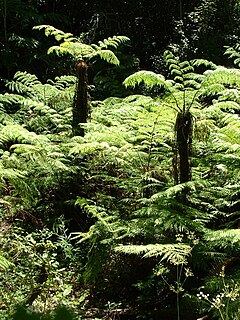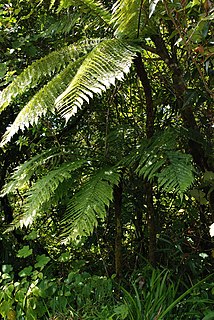
Cyathea medullaris, popularly known as the black tree fern, is a large tree fern up to 20 m tall. It is distributed across the south-west Pacific from Fiji to Pitcairn and New Zealand. It is called mamaku, katātā, kōrau, or pītau in the Māori language.
Cyathea affinis is a variable species of tree fern native to Fiji, Samoa, the Cook Islands, Austral Islands, Tahiti, and the Marquesas Islands. The trunk of this plant is erect and 2–6 m tall. Fronds are bipinnate and 2–3 m in length. The rachis and stipe are pale to brown in colour, or flushed with red towards the pinnule rachis. The stipe is sparsely covered in narrow basal scales, which are pale to dark and have broad fragile edges. Characteristically of this species, the lowest one or two pairs of pinnae may be slightly reduced and occur towards the base of the stipe. Sori are located near the pinnule midvein and are partially or fully covered by indusia, which open towards the pinnule margin.

Cyathea aneitensis is a species of tree fern native to Vanuatu and possibly New Caledonia. This species has an erect trunk up to 3 m tall. Fronds are bipinnate and may reach 2 m in length. The rachis and stipe are either very dark and smooth or have a few scales towards the base of the stipe. The scales are dark and narrow. Sori occur near the pinnule midvein and are covered by large, thin, fragile indusia. The closest relative of C. aneitensis appears to be Cyathea vieillardii. It can be distinguished from that species by its very dark stipes and frond bases.
Cyathea atropurpurea is a species of tree fern native to the islands of Luzon, Mindanao, Leyte and Mindanao in the Philippines, where it grows in forest at above 1000 m. The erect trunk is slender and may be up to 3 m tall. Fronds are bipinnate and 1–2 m long. Characteristically of this species, the final pair of pinnae are usually reduced and occur towards the base of the stipe. These, along with the stipe bases, are persistent and retained around the trunk long after withering. The stipe itself is dark and covered with scales, which are either small, dull and brown or large, dark and glossy. Sori occur near the midvein of fertile pinnules and lack indusia. Fertile pinnules are notably smaller than sterile ones.
Cyathea baileyana, also known as the wig tree fern, is a species of tree fern native to northeastern Queensland in Australia, where it grows in wet gullies and forest at an altitude of 850–1200 m. It is a rare species that is seldom found in the wild. The erect trunk is 4–5 m tall, approximately 10 cm in diameter and may be covered in stipe bases in the upper regions. C. baileyana is notable for being able to develop offshoots from the base of the trunk. Fronds are bi- or tripinnate and may be exceptionally long, up to 7 m, though they are usually around 2–3 m. The rachis and stipe are dark to darkish red, scaly and may be warty, but lack spines. Scales on the rachis and stipe are purplish brown to black and have a long hair-like apex. Characteristically of this species, the last pair of pinnae are separated from the others along the rachis and may form a clump around the trunk apex. Sori are circular and occur in one to three rows along the pinnule midvein. They lack indusia.

Cyathea capensis is a regionally widespread and highly variable species of tree fern. It is indigenous to Southern Africa and South America.
Cyathea caudata is a species of tree fern native to the islands of Luzon and Mindanao in the Philippines, where it grows in montane forest. The trunk is erect and up to 4 m tall or more. Fronds are bi- or tripinnate and 1–2 m long. The stipe is warty and covered with dark, narrow, glossy scales. Sori are borne near the midvein of fertile pinnules and are protected by firm, brown indusia.
Cyathea cucullifera is a species of tree fern native to eastern New Guinea, where it grows in montane forest at an altitude of about 2400 m. The trunk is erect and 2–3 m tall. Fronds are bi- or tripinnate and 2–3 m long. Characteristically of this species, they occur in two whorls of four to six fronds each. The stipe is warty and covered with scales. The scales are dark, glossy, have a narrow paler margin and are large towards the base. Sori occur near the fertile pinnule midvein and are covered by thin, pale brown indusia that are scale-like in appearance.

Cyathea dregei is a widespread species of tree fern in southern Africa.
Cyathea squamulata is a species of tree fern native to the Malay Peninsula, Sumatra, Java, Borneo and the southern Philippines, including the Sulu Archipelago, where it grows in forest from the lowlands to an altitude of about 1500 m. The trunk is erect and up to 2 m tall. Fronds are pinnate or bipinnate and approximately 1.5 m long. The stipe is covered in densely packed firm, medium brown scales. Sori occur near the fertile pinnule midvein and lack indusia.
Cyathea recommutata is a species of tree fern native to the Malay Peninsula, central and southern Sumatra and Borneo, where it grows in acidic peaty or sandy soils in wet forest, as well as swamp forest, from sea level to an altitude of 1500 m. The trunk is erect and rarely taller than 3 m. Fronds are bipinnate and 1–2 m long. Characteristically of this species, the lowest pair of pinnae are usually reduced and occur towards the base of the stipe. The stipe itself is dark dark and bears dark, glossy basal scales with thin, fragile edges. Fertile pinnules are notably smaller than sterile ones. Sori occur near the fertile pinnule midvein and lack indusia.
Cyathea gleichenioides is a species of tree fern endemic to New Guinea, where it grows in open peaty grassland and on forest margins, often in groups, at an altitude of 2800–3700 m. The trunk of this plant is erect, up to 3 m tall and about 24 cm in diameter. The narrow fronds are tripinnate and about 1 m in length. Around 60 fronds form a rounded crown.The stipe is warty and bears scattered scales towards the base. These scales may be either glossy brown with a paler dull margin, or small, pale and fringed. Sori occur one or two per fertile pinnule and are protected by firm, brown indusia.
Cyathea propinqua is a species of tree fern native to Fiji and possibly Samoa, where it grows in wet forest. The trunk of this plant is erect and slender, growing to 10 m in height. Fronds may be bi- or tripinnate and 2–3 m long. Dull brown scales cover the dull, dark stipe of this species. The scales are minute along most of its length, becoming thick and fleshy towards the base. Sori are borne halfway between the pinnule midvein and the edge of the lobe. Indusia are present.
Cyathea metteniana is a species of tree fern native to the Ryukyu Islands, Japan, and Taiwan, where it grows in wet forest, forest margins, and on hillsides. The trunk of this plant is erect, up to 1 m tall, and 6–10 cm in diameter. C. metteniana has tripinnate fronds that are 1-2.5 m long. The stipe is brown to purple-black in colouration. It is covered in long, broad-based scales that are usually bicoloured. Sori are round, lack indusia, and occur in two rows, one on either side of the pinnule midvein.
Cyathea imbricata is a species of tree fern endemic to Western New Guinea, where it grows in open forest at an altitude of 3240 m. The trunk of this plant is erect and approximately 2 m tall. Fronds may be bi- or tripinnate and are usually less than 1 m in length. The stipe is dark, spiny, and covered with caducous scales. These scales are glossy brown in colouration and have a paler margin and fragile edges. Sori are borne in groups of one to four per pinnule lobe. They are protected by firm indusia.

Cyathea incisoserrata is a species of tree fern native to the Malay Peninsula and the state of Sarawak on the island of Borneo, where it grows in forest and forest margins from the lowland to approximately 1250 m. The trunk is erect, about 4 m tall and 12 cm in diameter. Fronds may be bi- or tripinnate and 1–2 m in length. The stipe of this species is partly persistent and is sometimes retained on the upper trunk. It is warty, bears conical spines, and is sparsely covered with scales. These scales may be either small and fringed or bullate. Sori are borne near the fertile pinnule midvein. They are protected by very small, often bilobed indusia.
Cyathea kermadecensis is a species of tree fern endemic to Raoul Island in the Kermadec Islands, where it is locally common in damp, and sometimes drier, forest and scrub. The trunk of this plant is erect, slender, and up to 20 m tall. It is often covered with scars of old stipe-bases. Fronds are tripinnate and up to 4 m in length. The rachis and stipe are both brown in colouration and bear basal scales that are brown, glossy, and often twisted. Sori are borne on either side of the pinnule midvein. They are covered by hood-like indusia.
Cyathea latebrosa is a common and widespread species of tree fern native to Indochina. Its natural range covers Cambodia and Thailand, and stretches from the Malay Peninsula to Indonesia, where it is present on the islands of Borneo and Sumatra. Plants reported from India and Sri Lanka have thinner indusia and may represent a separate, as-yet undescribed, species. C. latebrosa grows in a wide range of habitats, including forest, secondary forest, and plantations, from sea level up to an elevation of about 1500 m.

Cyathea borbonica is a tree fern endemic to Mauritius, Réunion and the islands of the south-western Indian Ocean. There are several natural forms and varieties.










